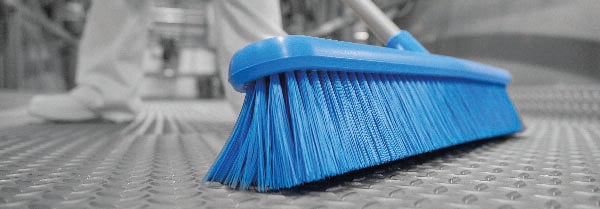World Class Quality, World Class Safety.
All Hillbrush products have been produced using specifically chosen materials and techniques to allow Hillbrush brushes and products to be multi-functional and corroborating to good product manufacturing practices at customers sites.
Some tools have been designed with specific tasks or nature of the product in mind, but the overall suitability needs to be a combination of tools and inspection of equipment/area to be cleaned.
To ensure the longevity of the cleaning tool, minimisation of foreign body contamination and effectiveness of the cleaning process, production equipment and area should be visually checked and improved whenever possible.
EHEDG, an organisation that supports and shares the benefit of hygiene product design in manufacturing, advises that key principles are followed when manufacturing or reviewing equipment and manufacturing areas to ensure suitable cleanability.
When reviewing equipment in use, the most applicable rules are below:
When looking at the production environment, certain areas are key to ensure cleaning can take place appropriately and are highlighted below:
Many other areas need to be inspected such as how cables travel within the production area, how pipework and walls/ceilings contact areas are protected from contamination.
If you are interested in learning more about these aspects, check the EHEDG website: www.EHEDG.org.
If you would like support in reviewing cleaning activities and advice on how this can be improved, contact us at the bottom of this page.
Hillbrush hygiene products have been manufactured to comply with FDA and EU Regulation 852/2004 and amended EU Regulation 1019/2008 on the Hygiene of Foodstuffs, and US Food Code Part 4-101-11.
Hillbrush hygiene products comply with the requirements of the following European Commission Regulations:
A functional barrier is used in antimicrobial Hillbrush tools, and the active ingredient is present on the provisional list of additives permitted to be used in plastics relating to EU Directive 10/2011. As from 1 January 2010 the list of additives in EU Directive 10/2011 relating to materials and article intended to come into contact with foodstuffs became a positive list to the exclusion of all others. Antimicrobial material or article complies with the requirements of Article 13(2), (3) and (4) or Article 14(2) and (3) of Regulation (EC) No 10/2011.
It is essential to take care of your hygiene cleaning equipment and recognise when they need replacing. Below you will find hints and tips for the best way to maintain your brushware and hygienic tools.
As part of pre-requisites programmes, cleaning activities need to be fully controlled and audited at regular intervals. Inspection of cleaning tools is part of the compliance ensuring cleaning equipment is only used if suitable and kept clean.
To keep your tools in good working order and hygienic:

Would you like to get more information? Schedule a meeting with one of our experts.

Interested in a specific product? Request a product sample from us today.
.jpg)
Is an audit approaching? Schedule a free, no-obligation site inspection with Hillbrush